Our History
Despatch Industries’ legacy is founded on the critical principles of service, quality and innovation. Using these principles as guidelines for its business has created a path of great growth and success for Despatch in its 100+ year history. The company prides itself on producing the highest quality products possible, and providing an unmatched level of customer service. The innovative spirit of the company drives employees to seek new technologies and solutions to better meet customer’s needs. Though Despatch is a leader in the markets it serves, the company remains nimble and diversified in order to quickly respond to changing times and market environments.
The company’s philosophies and innovations have allowed Despatch to grow and thrive for a century, and to move full-speed into its next 100 years of success.
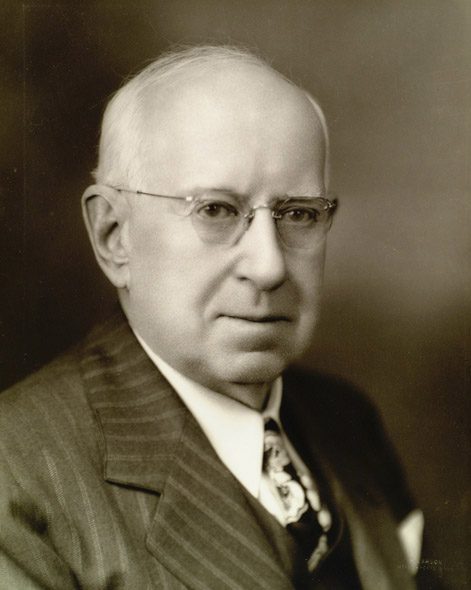
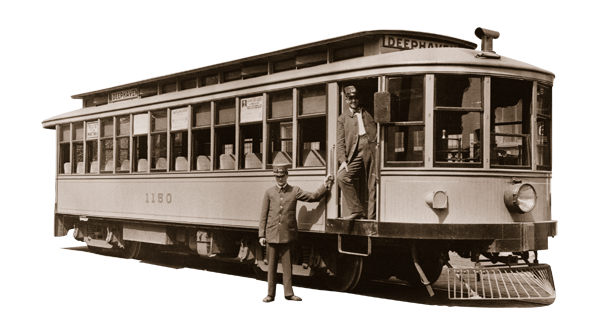 1902: Albert E. Grapp starts his first business, Despatch Industries
with plans to service and repair electrical items that were just beginning to be invented in the
early 1900s. It wasn’t long before the innovative entrepreneur was building electric heaters
for frigid Minneapolis streetcars and developing flour drying ovens for milling companies like
Pillsbury.
1902: Albert E. Grapp starts his first business, Despatch Industries
with plans to service and repair electrical items that were just beginning to be invented in the
early 1900s. It wasn’t long before the innovative entrepreneur was building electric heaters
for frigid Minneapolis streetcars and developing flour drying ovens for milling companies like
Pillsbury.
1904: Grapp devised a small flour testing oven for Pillsbury. The oven was lined with tile for more consistent heating and provided heating accuracy to plus or minus 10 degrees Fahrenheit – a first in the business.
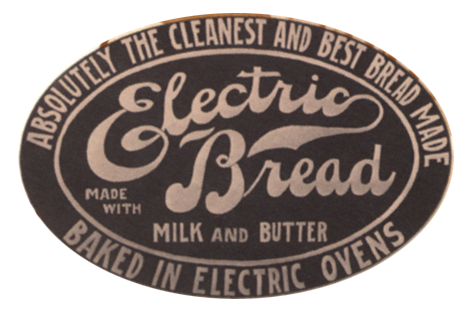 1913: Despatch Manufacturing Company was officially incorporated in
the state of Minnesota.
1913: Despatch Manufacturing Company was officially incorporated in
the state of Minnesota.
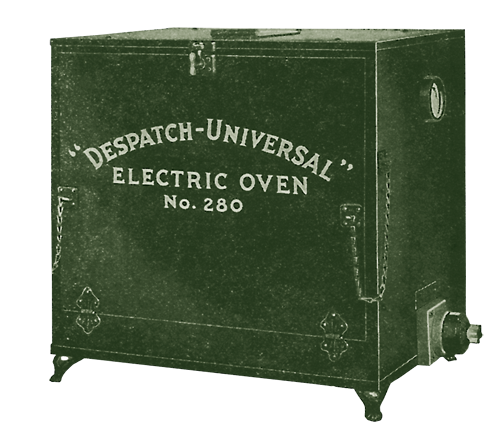 1916: Grapp invents an electric oven for baking bread. The product
was packaged as the Electric-Maid Bake Shop, a franchise system to sell complete bakeshops.
1916: Grapp invents an electric oven for baking bread. The product
was packaged as the Electric-Maid Bake Shop, a franchise system to sell complete bakeshops.
1917: America enters World War I. Despatch invents small, custom ovens for armament production, as well as larger foundry and finish bake ovens for steel producers in America and Europe.
1921-1923: Despatch has customers in six states. Customers include the Bloom Brothers, a manufacturer of Indian moccasins with an order for a unique leather drying oven; and Brooklyn Street Railway in New York City that ordered an electrically heated oven to dry out motor generators.
1924: Despatch finances its first power hacksaw, drill presses and small lathes to
streamline steel cutting instead of doing it all by hand.
Despatch creates its own sales organization and hires the company’s first agent, based in
Pittsburgh.
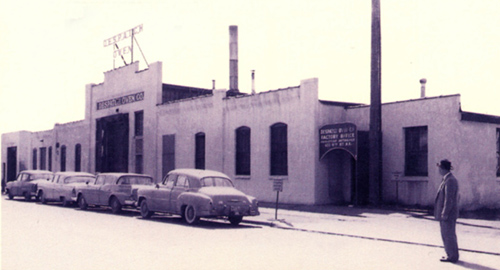 1925: Despatch receives a request from Moore Bedding Company to build
its first continuous conveyor oven for baking bed springs after they were dip-painted.
1925: Despatch receives a request from Moore Bedding Company to build
its first continuous conveyor oven for baking bed springs after they were dip-painted.
1926: Despatch develops a relationship with Bennett Insulation Company, a Minneapolis neighbor, and is entered in a new industry, creating ovens to dry piping insulation.
1928: Despatch opens its second sales office in Chicago.
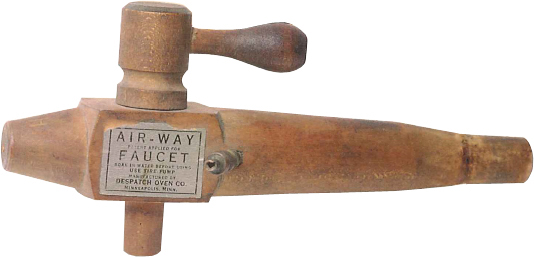 1932:
Grapp helps the company survive the Great Depression by inventing a beer spigot using a cycle valve
that could be used to pressurize a beer barrel. His invention comes just in time as Congress
repealed prohibition in 1933.
1932:
Grapp helps the company survive the Great Depression by inventing a beer spigot using a cycle valve
that could be used to pressurize a beer barrel. His invention comes just in time as Congress
repealed prohibition in 1933.
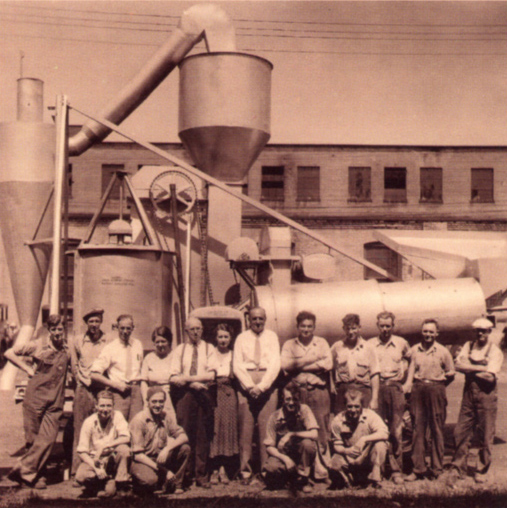 1934: Despatch makes its largest installation to date when it creates
a system to process a variety of parts for Seeger Refrigerator Company.
1934: Despatch makes its largest installation to date when it creates
a system to process a variety of parts for Seeger Refrigerator Company.
1935: Mr. Grapp, along with a couple of promoters, develops a new machine to be used in gold mining.
1938: Despatch builds ovens large enough to supply up to 3.5 million BTUs, and some designs include multiple conveyors. The company designs an oven for the Stetson Hat Company.
1939: World War II begins. Despatch is hired by the U.S. Navy to build waterproof ovens for repair shops on ships, as well as ovens for treating airplane parts and ammunition shells.
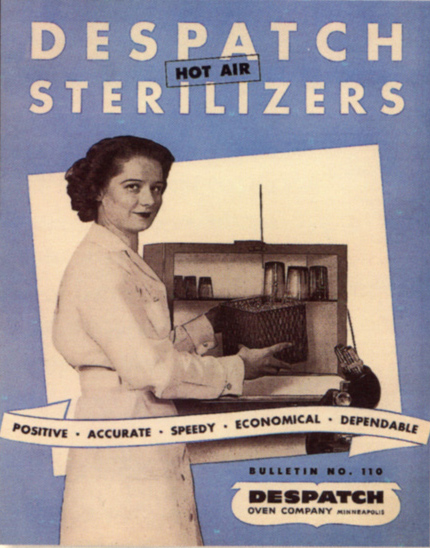 1941: America enters World War II and new opportunities arise for
Despatch. The company makes its first high-temperature furnace to treat magnesium castings used in
airplane wheels and other structural parts of planes for the Hitchcock Foundry of Minneapolis.
Despatch builds the first experimental furnace for steel shell case manufacturers at the Frankfurt
Arsenal in Philadelphia.
1941: America enters World War II and new opportunities arise for
Despatch. The company makes its first high-temperature furnace to treat magnesium castings used in
airplane wheels and other structural parts of planes for the Hitchcock Foundry of Minneapolis.
Despatch builds the first experimental furnace for steel shell case manufacturers at the Frankfurt
Arsenal in Philadelphia.
1943: Despatch designs ovens for hot air and dry heat sterilization of glassware, needles and flasks.
1946: Minnesota Mining and Manufacturing Company (3M) needs ovens for
manufacturing Scotch™ Cellophane Tape and calls on Despatch.  Despatch Baker Boy ovens, “the
small oven for a big job”
Despatch Baker Boy ovens, “the
small oven for a big job”
1947: Despatch manufactures conveyor systems to carry small parts, including radio and TV components, through curing ovens. GE and Westinghouse become Despatch customers.
1948: With its growing expertise, Despatch starts producing tower, batch and molding ovens for large US companies, including a fully-automated system measuring 200 feet long for John Deere.
1951: Despatch designs a finishing system for the Pentagon that helps produce 200-pound projectiles for missiles. This assignment leads to others, including a finishing system for the Titan 2 missile nosecone made by Martin Marietta Company.
1952: Despatch designs and builds its first gas-fired, radiant tube quick quench furnace. The furnace was elevated, and its floor opened up to a quenching pit full of water. This unique system is widely used to heat-treat aluminum spars and wing sections for airplanes.
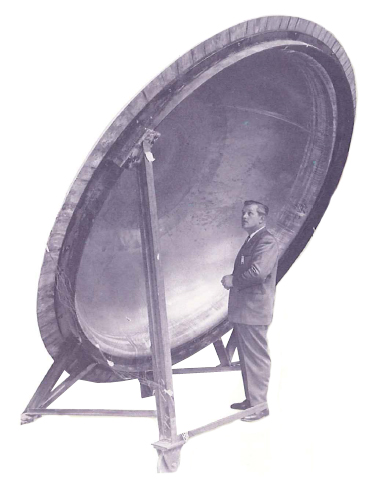 1954: Despatch works with Douglas Aircraft to develop a preheating
oven to shape Plexiglas® windshields for fighter aircraft.
1954: Despatch works with Douglas Aircraft to develop a preheating
oven to shape Plexiglas® windshields for fighter aircraft.
1955: Ford Motor Company asks Despatch to build a windshield bending system. 
1958: Despatch sells a lab oven to Dave Packard, the co-founder of Hewlett Packard.
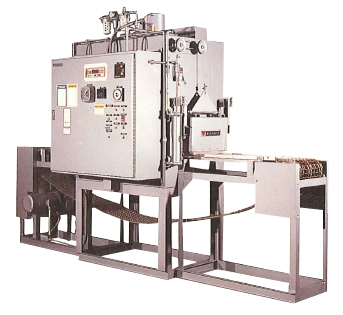 1960-1962: Despatch designs a sophisticated and fast conveyor system
capable of handling hardboard pieces ranging from one foot to sixteen feet for the wood
pre-finishing industry.
1960-1962: Despatch designs a sophisticated and fast conveyor system
capable of handling hardboard pieces ranging from one foot to sixteen feet for the wood
pre-finishing industry. 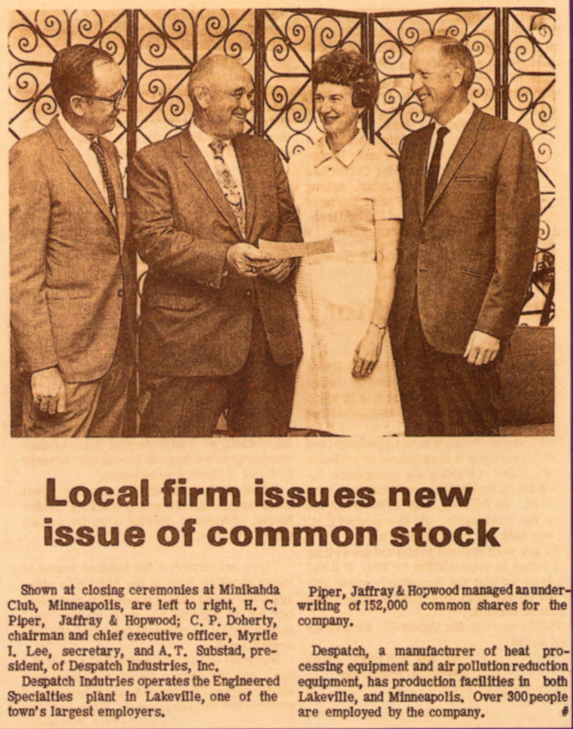 The company invents a semiconductor diffusion furnace and a custom oven
for the pharmaceutical industry.
The company invents a semiconductor diffusion furnace and a custom oven
for the pharmaceutical industry.
1964: Construction starts on major new addition to Despatch offices.
1968: Despatch produces its first commercial, self-cleaning convection oven and – in a joint venture with Possis, another Minneapolis company – creates a shrink-wrapping system.
1969: After years of strong sales and profitability, Piper, Jaffray & Hopwood takes Despatch public.
1970: Despatch is a dominant player in semiconductor burn-in equipment for the
rapidly growing U.S. electronics industry. Despatch offers a standard line of ovens, as well as
custom units. 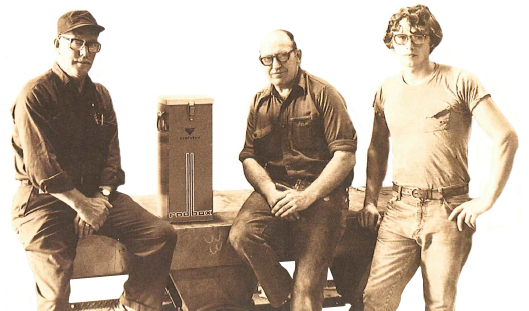 Revolutionaire, a three-deck pizza oven was developed by Despatch in 1970.
Revolutionaire, a three-deck pizza oven was developed by Despatch in 1970.
1976: Despatch celebrates manufacturing its 100,000th piece of equipment.
1977: Despatch key customers include 3M, Ford, General Motors and EG&G Wakefield, a burn-in electronics company that sells test chambers to Intel.
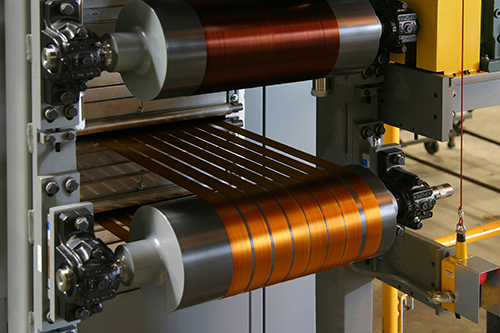 1982: Despatch acquires Ransco Industries, a California-based company
that specializes in cold process equipment and starts producing its first line of environmental
chambers.
Despatch supplies a curing oven system for the production of latex gloves to Becton-Dickinson.
1982: Despatch acquires Ransco Industries, a California-based company
that specializes in cold process equipment and starts producing its first line of environmental
chambers.
Despatch supplies a curing oven system for the production of latex gloves to Becton-Dickinson.
1985: Despatch receives a patent for its new carbon fiber treatment system.
1987: Despatch ships and installs the first U.S. made, self-sterilizing depyrogenation tunnels. A patent on this technology, that dries and sterilizes drug bottles, gives the company an entry into the high-speed, injectable drug-filling market.
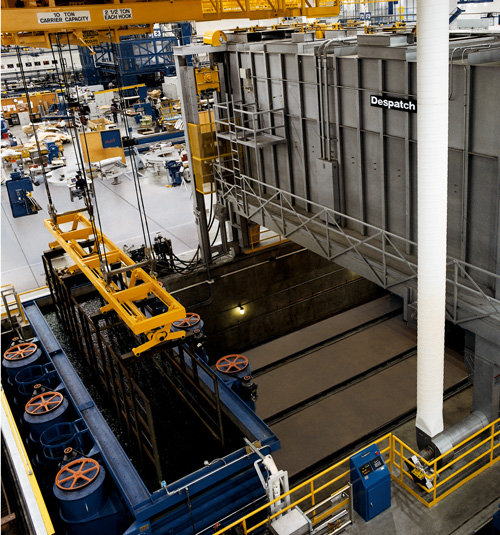 1988: Boeing expands its sheet metal facility and Despatch supplies
the company with its first mobile, quick-quench furnace system.
Despatch develops a H.A.S.T. (High Accelerated Stress Test) Chamber, to test semiconductor packaging
and a Plasma Thawing System for pharmaceutical applications.
1988: Boeing expands its sheet metal facility and Despatch supplies
the company with its first mobile, quick-quench furnace system.
Despatch develops a H.A.S.T. (High Accelerated Stress Test) Chamber, to test semiconductor packaging
and a Plasma Thawing System for pharmaceutical applications.
1989: Despatch explores microwave applications for the rubber industry and builds new systems used in the manufacturing of read-write heads for IBM and Seagate disk drives. The company also builds large-scale automotive electronics environmental testing systems for General Motors and Ford.
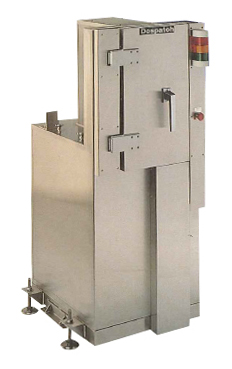 1991: Despatch develops the MCM polyimide cure system, for Multi-Chip
Modules in the electronics industry.
1991: Despatch develops the MCM polyimide cure system, for Multi-Chip
Modules in the electronics industry.
1992: Despatch creates a $2 million, patented production radiant tower treater for the Arlon Company.
1993: Despatch produces its first Magnetic Annealing Oven used for photo resist
curing, required in the production of disk drive recording heads. 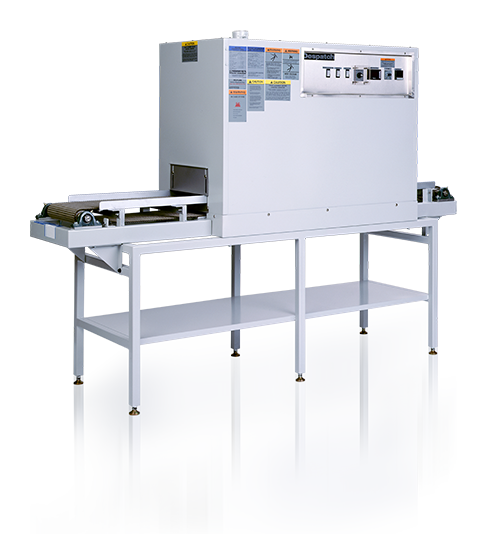 Despatch pioneers an innovative
barrier isolation technology for the pharmaceutical industry that helps ensure that sterile
packaging, used when filling vials with liquid drugs, was not inadvertently contaminated.
Despatch pioneers an innovative
barrier isolation technology for the pharmaceutical industry that helps ensure that sterile
packaging, used when filling vials with liquid drugs, was not inadvertently contaminated.
1994: Despatch develops the UV360, a surface decontamination system for the pharmaceutical industry that decontaminates pre-sterilized packages before they are taken to sterile environments.
1995: PCC Small conveyorized ovens were used in a variety of drying and curing operations for electronics manufacturing.
1997: Despatch launches its first website.
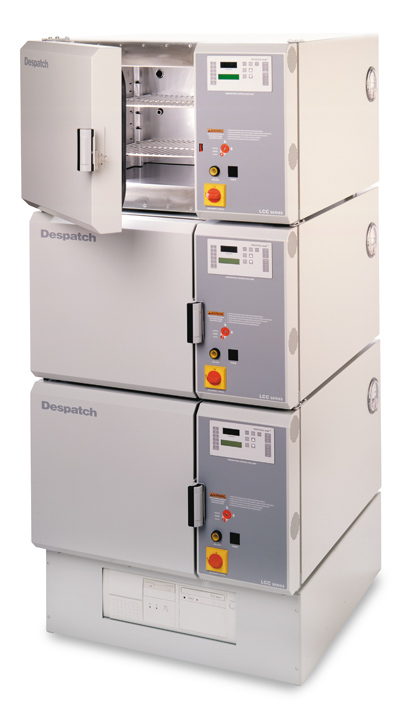 2000: Despatch is awarded several large Solution Heat Treat Furnace
projects from aerospace manufacturing companies.
2000: Despatch is awarded several large Solution Heat Treat Furnace
projects from aerospace manufacturing companies.
Despatch finds quick success with its new PTC oven for testing down-hole electronic logging
equipment. The petroleum industry uses down-hole logging equipment to seek out new oil sources.
2001: LCC stackable clean process ovens were designed to save clean manufacturing floor space.
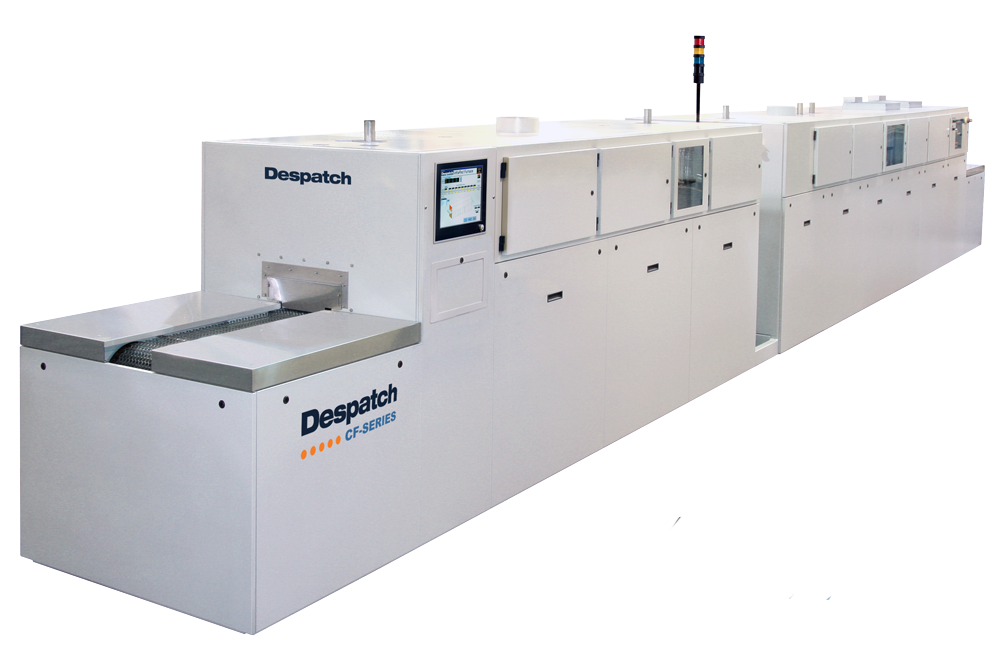 2002: Despatch celebrates its 100-year anniversary.
2002: Despatch celebrates its 100-year anniversary.
2005: Despatch is introduced to infrared technology and enters into the solar cell manufacturing market with the launch of its new CF/CDF metallization firing and drying furnace product line.
2005-2009: Despatch expands its global presence by opening regional offices in Shanghai, China; Berlin, Germany; and Taipei, Taiwan.
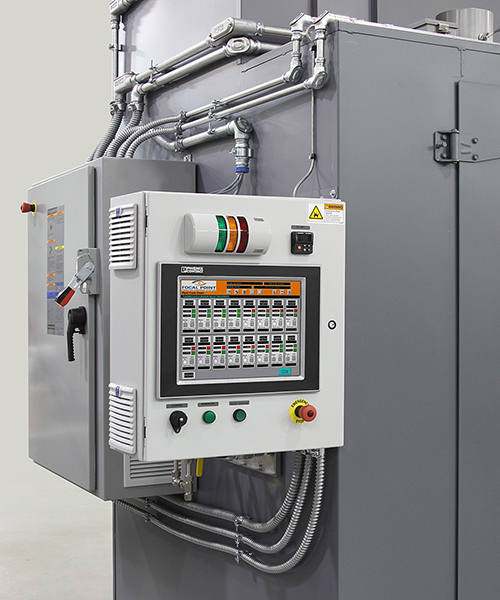
2011: Despatch is acquired by Illinois Tool Works.
2012: Focal Point process control system developed for composite curing is introduced. Focal Point™ fully controls the curing process and documents all process information, providing traceability and validation of part quality on all Despatch composite curing ovens.
2012: Despatch produces first micro-scale carbon fiber production line for
Australia’s Deakin University research facility.
New Safire firing furnace and DriTech Dryer is introduced. The Safire firing furnace, together with
the DriTech dryer, were designed to provide solar manufacturers with the ability to properly
segment, control and adjust key process parameters in order to achieve maximum product yield,
quality and consistency.
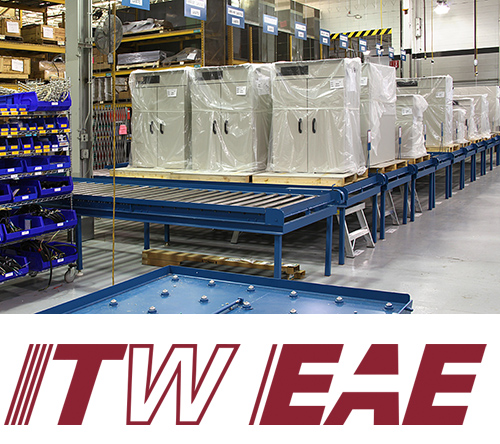 2013: Despatch implements new manufacturing processes that reduces
lead times by 50% or more. The company restructured its manufacturing facility to allow for
in-lining of production equipment and assembly stations that improve flow and minimize production
time
2013: Despatch implements new manufacturing processes that reduces
lead times by 50% or more. The company restructured its manufacturing facility to allow for
in-lining of production equipment and assembly stations that improve flow and minimize production
time
2017: ITW integrates three of its businesses; Speedline Technologies, Vitronics Soltec and Despatch Industries. This new division consolidates all its Electronic Assembly Equipment and Thermal Processing Technology business and begins operating under the name ITW EAE.
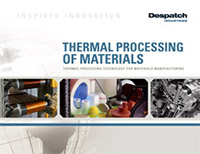 Join the Despatch team
Join the Despatch team
Review our job positings and see if you qualify for a challenging and rewarding position at Despatch Industries.
An ITW company
Despatch Industries is one of ITW’s 825 decentralized business units. ITW employs approximately 60,000 men and women who are focused on creating value-added products and innovative customer solutions.


